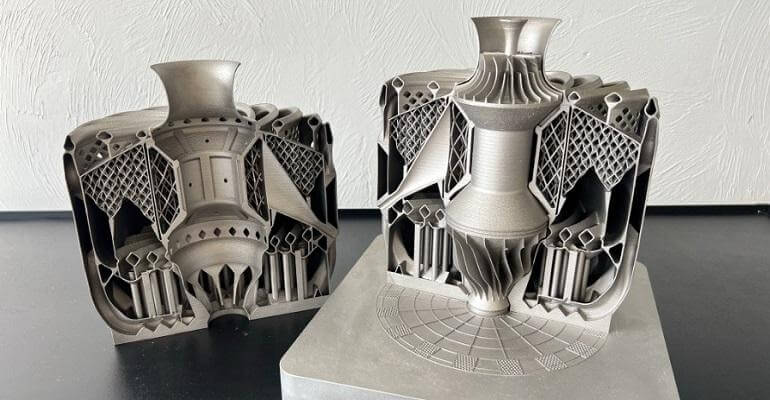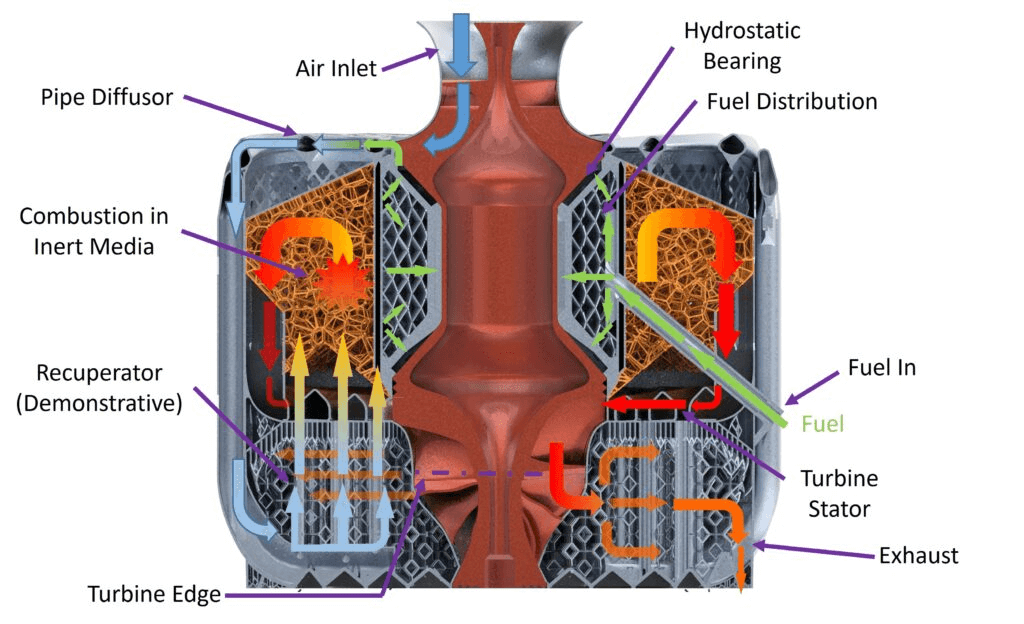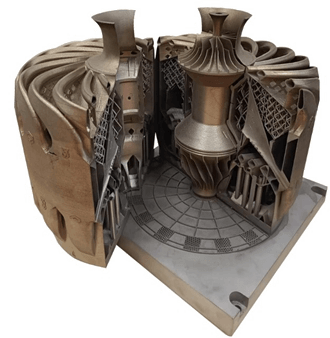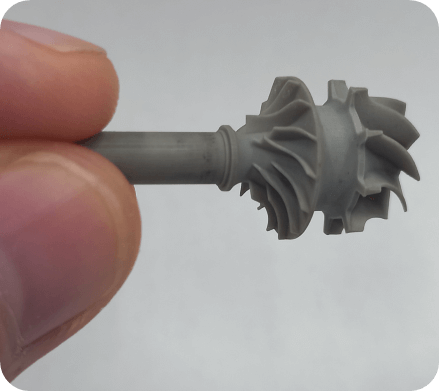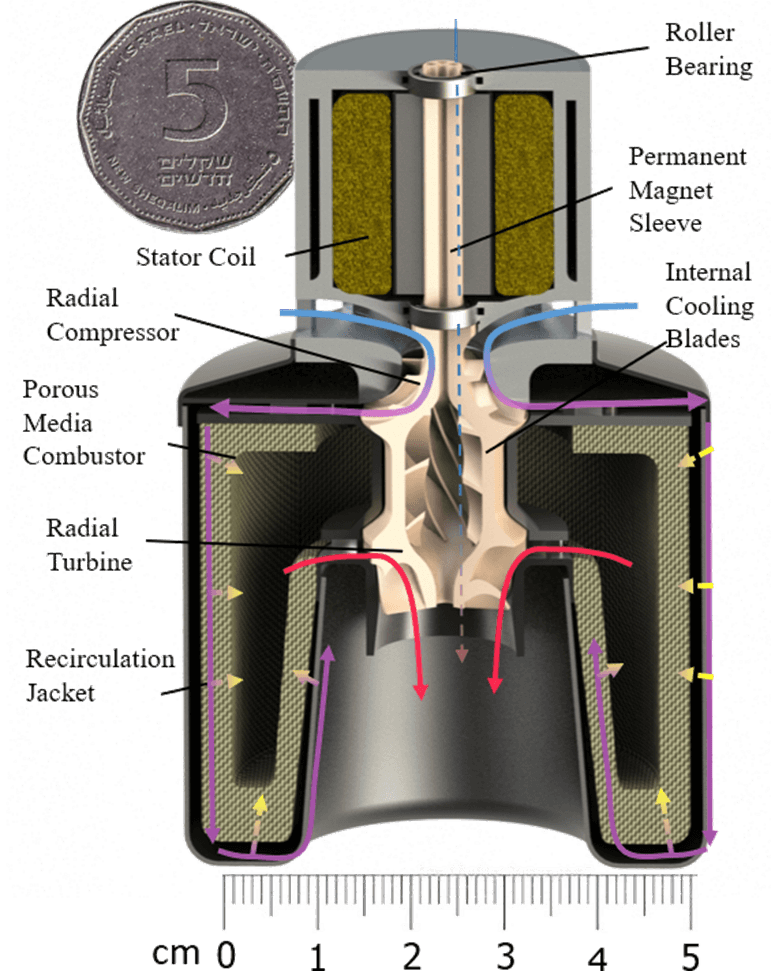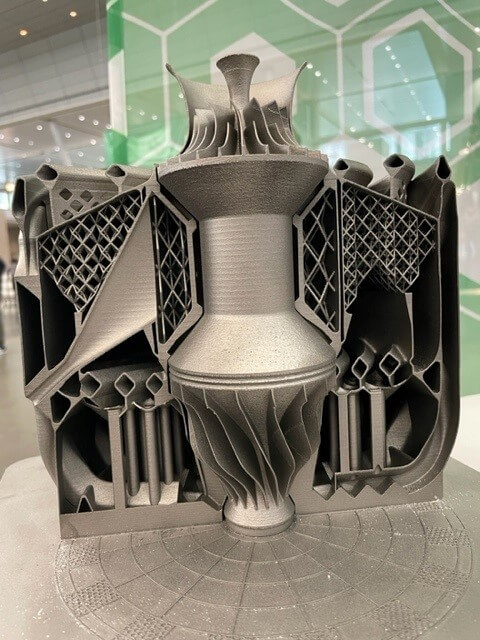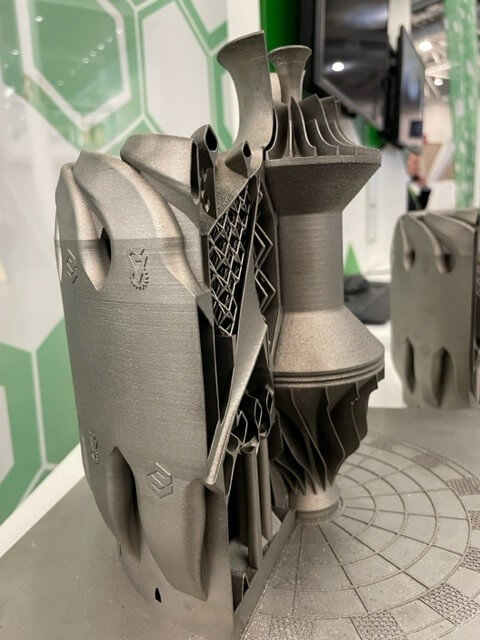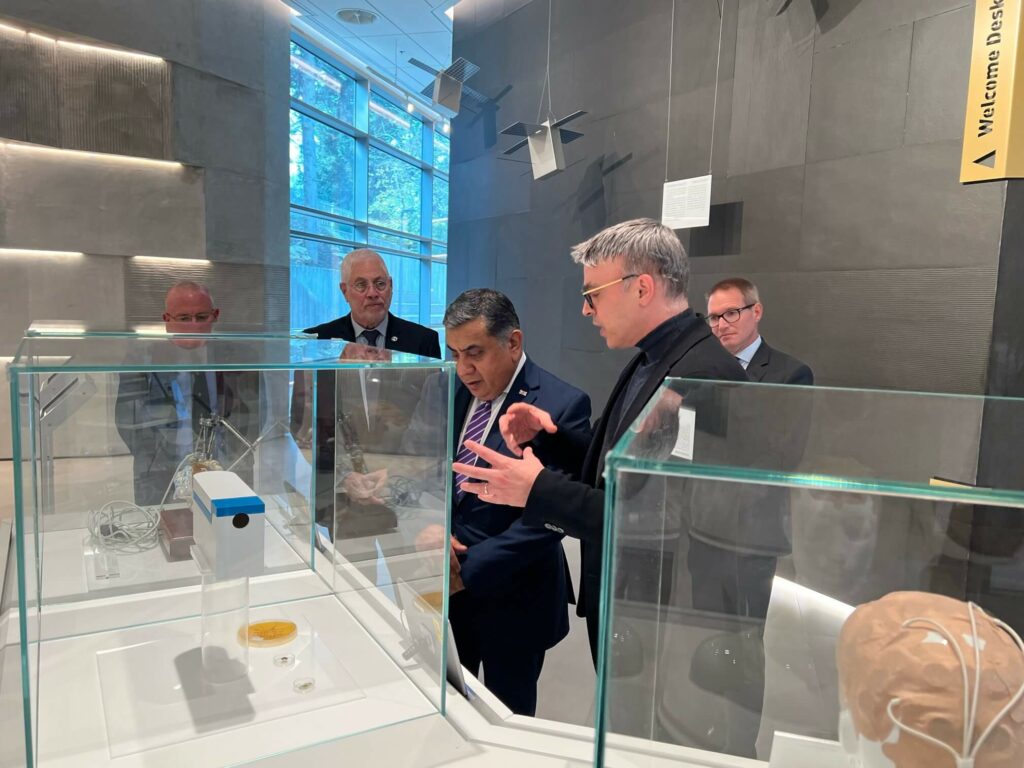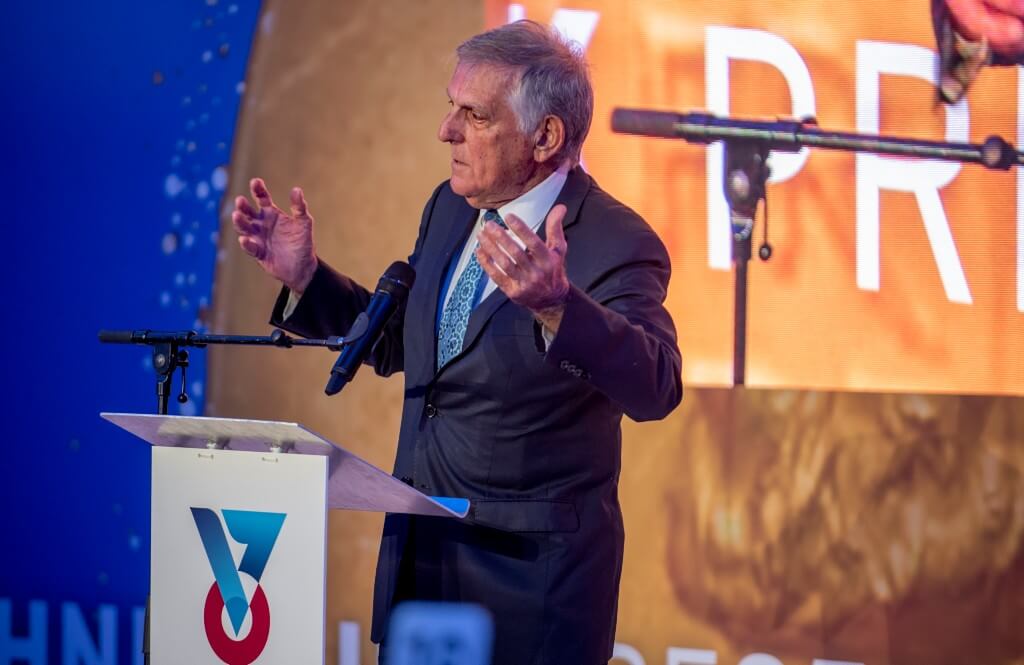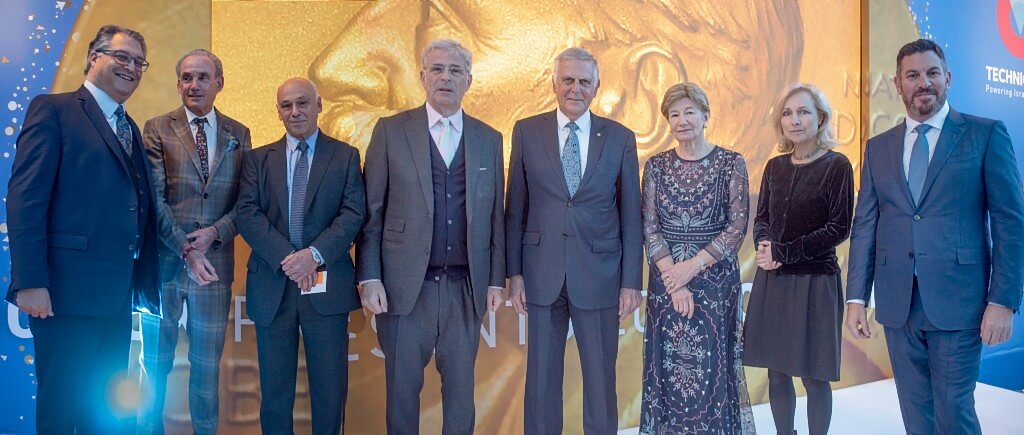In a huge step towards the future of power generation and propulsion, a team led by Associate Professor Beni Cukurel at Technion – Israel Institute of Technology, has designed a micro gas turbine using additive manufacturing (AM), also known as 3D printing. This revolutionary development presents an ingenious approach towards the ‘Design for Additive Manufacturing’ principle, significantly challenging conventional manufacturing paradigms.
Geometric Technology Demonstrator of Additively Manufactured Pre-Assembled Micro-Turbojet Engine. Photo via Technion Turbomachinery and Heat Transfer laboratory.
Unlike conventional manufacturing techniques, Cukurel’s team and the Turbomachinery and Heat Transfer laboratory tapped into the potential of AM in its purest form. In his words, “When you’re using [AM] just as another manufacturing technique, you’re not really fully capitalizing on the benefits of additive manufacturing.” Rather than simply integrating AM as an alternative tool, the team reimagined it as a core resource, creating designs a priori to satisfy constraints and leverage the benefits of AM.
At the heart of their research are micro gas turbines, designed for proportionate power generation. Cukurel defines micro gas turbines as systems capable of generating electricity below 300 kilowatts and thrust below two kilonewtons. Taking the AM approach, the team started their first project, a 5cm scale micro gas turbine that could potentially provide 300 watts for a drone. The micro turbine offers a significant increase in flight time due to its higher energy density compared to conventional batteries.
Functionality of various path indicated by gas and fuel path. Image via Technion Turbomachinery and Heat Transfer laboratory.
The team didn’t stop at the micro gas turbine; they further leveraged their AM knowledge during the COVID-19 crisis. They innovated a pre-assembled, self-supported turbomachinery design for medical ventilators. “We transitioned this know-how that we developed in pre-assembled self-supported turbomachinery architectures to gas turbines,” said Cukurel.
The breakthrough offered by these pre-assembled, self-supporting micro gas turbines hinges on their on-demand availability and cost-effectiveness. The primary cost is confined to machine time and power consumption, considerably reducing production expenditure.
Cukurel acknowledged that such innovative work was only possible due to a fruitful collaboration with von Karman Institute for Fluid Dynamics, Izmir Katip Celebi University, and PTC. The NATO-funded project saw each party bring its unique expertise to the table. Von Karman Institute provided high-fidelity simulation for aerodynamics and combustion, Izmir Katip Celebi University lent its computational fluid dynamics skills for assessing the load-bearing capacity of hydrostatic bearings, and PTC offered its extensive knowledge in AM technologies, in particular through its powerful CAD design and simulation framework, Creo.
Self-supported Rotor (turbine-shaft-compressor) and Encompassing Self-supported Stationary Housing (recuperator, nozzle guide vanes, bearing housing, combustor, diffusor). Photo via Technion Turbomachinery and Heat Transfer laboratory.
Optimizing performance with additive manufacturing
Addressing the constraints of design for additive manufacturing, Cukurel explains that they began by developing a reduced order model. In simple terms, this is an optimized model that maintains the crucial aspects of the original system, but simplifies it for easier analysis and use.
In designing a jet engine, traditionally, aerodynamics takes center stage. The goal is to achieve peak performance in terms of thermodynamics, translating to the thrust-to-weight ratio and specific fuel consumption, or in other words, power and energy density. However, this approach falters when it comes to miniaturized engines.
“What we have created are reduced order models that capture all the disciplines present in the engine. These include aerodynamics, heat transfer, rotor dynamics, and combustion, among others,” Cukurel explains. Think of it like condensing a symphony into a solo performance – you need to maintain the essence of the piece while also accommodating the capabilities of the lone performer.
He continues to detail how they’ve created a multidisciplinary optimization environment that a priori knows all the constraints of additive manufacturing. This basically means they’ve designed a system that, from the beginning, understands the limits of what it can create. It’s like an experienced architect who knows not to design a roof with angles too steep for the building materials to support.
They’ve ensured that every layer built during the manufacturing process is self-supported while obeying the constraints of additive manufacturing, which includes considerations for cantilever angles, minimum thicknesses, and porosity, among others.
When asked about the material used in the component being discussed, Cukurel confirms that it’s a metal part printed with an EOS M 290. “We’re also using Lithoz for all our ceramic manufacturing,” he adds. Lithoz is a ceramic manufacturing company that Cukurel speaks highly of, stating that they’ve been “very supportive and enthusiastic about this unique application of the technology.”
Ceramic components, while being tougher to manufacture, offer advantages like smaller defect sizes and smoother finishes, leading to improved aerodynamic performance. This performance translates into significant savings in fuel consumption, hence the potential appeal of using ceramics for specific components.
Cukurel concludes by emphasizing the importance of hitting the conceptual design target, noting that a deviation of as little as 5% can impact fuel savings or thrust by almost the same margin. In the world of jet engine design, even the smallest percentage points can lead to major changes. The compressor performance of the ceramic parts was aerodynamically somewhere between three to four percentage points greater, “I know it sounds small, but you know people sacrifice their firstborn child for the 1% difference in performance,” said Cukurel.
Monolithic additively manufactured silicon nitride rotor of ultra micro gas turbine, designed to operate at 500,000 RPM. Photo via Technion Turbomachinery and Heat Transfer laboratory.
Is the future of energy 3D printed?
The future of energy could be reinvented by Israeli researchers and their work on preassembled engines using 3D printing technology. Their project, focusing on the application of micro gas turbines in distributed energy generation, is shaking up conventional understandings of energy efficiency and creating new possibilities for sustainability.
Cukurel offered two distinct applications for the technology. Firstly, he highlighted military usage, specifically unmanned aerial systems. In this sphere, supply chain disruption is a significant concern, potentially leaving crucial operations without essential components like bearings for six to nine months. The preassembled engine technology circumvents this problem by eliminating the need for such a supply chain altogether.
The second, and arguably more compelling application, is in distributed energy generation. The conventional centralized power plants have an energy efficiency cap at around 65%, meaning 35% of energy generated simply goes to waste. Cukurel proposed a solution using combined heat and power with distributed micro gas turbines in localities.
5cm scale ultra micro gas turbine intended to produce 300w. Photo via Technion Turbomachinery and Heat Transfer laboratory.
He further explained, “Renewables are interrupted sources. You don’t want to rely on whether there will be wind today, right? Or there’ll be sun today. You want to run your factory no matter what. So then how do you have an agile, robust grid even when your renewables may or may not be producing?”
Agile in this context doesn’t mean sprinting around a track. It refers to the ability to quickly adapt and respond to changes in energy demand. In this case, those changes are the unpredictable outputs of renewable energy sources. Traditional centralized power plants aren’t exactly Usain Bolt in this race—they’re not built for quick changes. Small micro gas turbines, however, are.
Although the transformative potential of this technology is evident, a major obstacle lies in the return on investment. As it stands, the cost of these micro gas turbines is too high to yield a satisfactory ROI in a reasonable timeframe. Yet, the technology discussed here offers a potential breakthrough by drastically reducing the associated costs.
Furthermore, these researchers have plans to commercialize their work. A spinoff from Technion is in the pipeline, and partnerships with industry players and strategic investors are on the cards. Cukurel expressed his excitement at the potential societal impact of their work, particularly in enabling micro gas turbines to burn ammonia, which could act as a renewable, green, carbon-free fuel. He passionately explained, “Forget about all this work that I’ve mentioned to you. Okay, just to be able to have a micro gas turbine that’s burning ammonia, in terms of sustainability is a breakthrough.”
Ammonia has been used as fuel before, notably during World War II in Belgium, but the combustor designs for gas turbines have changed significantly since then. The technology Cukurel and his team have developed — a porous media combustor — is particularly suited for burning ammonia. While they didn’t invent the porous media combustor, they are the first to apply it to this landscape.
With my curiosity sufficiently piqued, I delved further into the mechanics of ammonia combustion.
Silicon carbide Porous Media Combustor providing wide stability for fuel/air ratios. Photo via Technion Turbomachinery and Heat Transfer laboratory.
Sustainable energy using ammonia engines
The wartime ammonia-powered engines presented a number of challenges, primarily their sensitivity to fuel and a general lack of flexibility. That’s why Cukurel and his team found gas turbines a more appropriate technology for their project.
“In gas turbines,” Cukurel explained, “most of the combustor designs use a completely different technology. They optimize for vaporization, then have these dilution tubes to meter the fuel, and introduce the hot gases into the turbine.” What sets the Technion team apart is their unique application of a specific technology – the porous media combustor. This is the first time it’s been applied to ammonia-burning micro gas turbines, making their work ground-breaking.
Let’s demystify the term ‘porous media combustor.’ It’s a special type of combustor where the fuel-air mixture is burned within a porous medium, creating highly efficient, low-emission combustion. This isn’t something new; it has been around for at least 50 years, with traditional manufacturing methods involving dipping foams into a ceramic slurry and then sintering them. However, as Cukurel points out, this gives you “no control over the porosity and how it gets distributed in the flow direction.”
The breakthrough lies in the application of additive manufacturing. I was fortunate enough to observe one of these combustors, and what caught my eye was its doughnut shape with an organic, bubble-like lattice structure inside. The porosity of this structure changes in the flow direction, which in this case is radially inward. This is where the utility of 3D printing comes in, as it allows for control of the porosity gradient that is impossible to achieve with traditional manufacturing techniques.
Porous Media Combustor operating with premixed fuel/air mixtures. Photo via Technion Turbomachinery and Heat Transfer laboratory.
Cukurel is also a co-author of a recent paper providing a comprehensive analysis of the design, production, assembly, and high-speed testing of monolithic rotors using Lithography-based ceramic manufacturing (LCM) and Selective Laser Melting (SLM) techniques. Entitled, Ceramic and metal additive manufacturing of monolithic rotors from sialon and Inconel and comparison of aerodynamic performance for 300W scale microturbines, this is the first study to directly compare micro-turbomachinery components made with these methods using aerodynamic and manufacturing quality assurance diagnostics. The paper examines the aerodynamic implications of support-free compressor and turbine design, formulates detailed manufacturing considerations and process parameters for both LCM and SLM, and conducts quality analysis of the parts through surface and CT scans, as well as SEM micrography. The results reveal that LCM rotors exhibit higher geometric detail, better surface finish, fewer manufacturing-related surface artifacts, and lower porosity compared to SLM rotors.
These groundbreaking concepts and future applications could change the world as we know it. As we face the existential threat of climate change, innovations like these are not just intriguing; they may be crucial for our survival.





